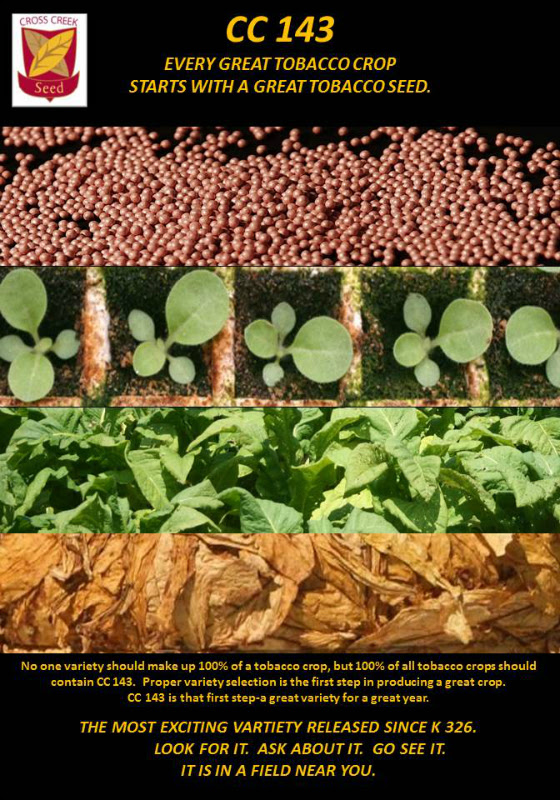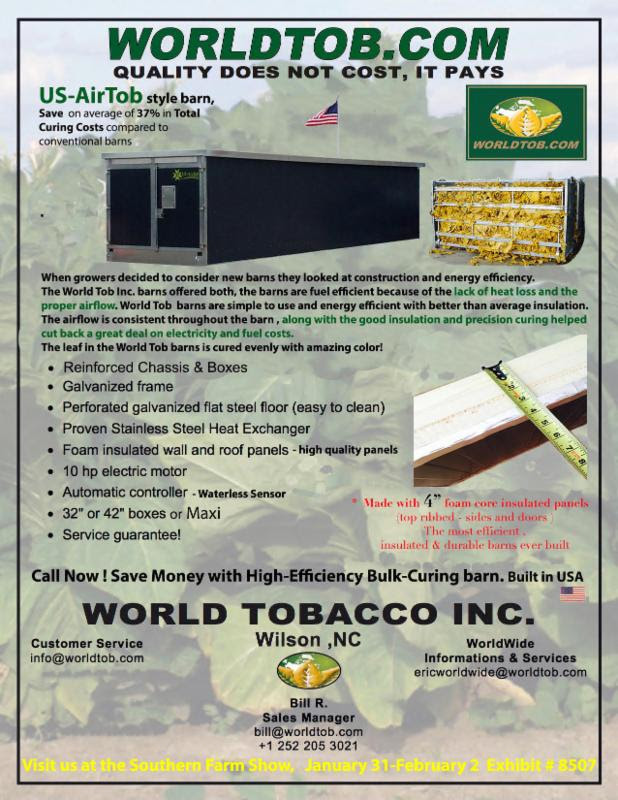Seeding is well under way in eastern North Carolina, says Matthew Vann, N.C. Extension tobacco specialist. And it is getting started in the west, he adds. "It is going pretty well so far. The ambient air temperatures have been good."
The only problem: Overcast conditions have reduced the light available for germination. "We like to see four or five consecutive days of clear, sunny skies when we seed," says Vann. "However, cloudy conditions do not seem to have caused any major issues to date."
When will transplanting begin in N.C.? To this point, one might expect that plants will get to the field in a timely manner, starting maybe April 15 to 20. "But we usually have some growers who want to get out sooner," Vann says.
Report from Ontario: Contracting is for the most part complete in Canada's tobacco-growing area of southern Ontario, says David VanDeVelde, flue-cured grower in Delhi, Ontario. Official statistics won't be available for a while, but VanDeVelde believes acreage pla-nted will be down slightly from 2017, when 193 growers contracted for 18,491 acres. In 2016, 195 growers contracted for 15,353 acres. VanDeVelde is the new chair of Ontario Flue Cured Tobacco Growers marketing board.
North of the border, labor is out of sight: Quite a few Canadian tobacco growers attended the Southern Farm Show in Raleigh earlier this month. Among them were Paul and Desiree Arva of Mount Pleasant, Ontario, who came down from Canada looking for labor-saving tobacco machinery. "We just had a big increase in in the minimum wage," they said. "We need to find any way we can to reduce the labor we need to produce a crop."
VanDeVelde confirmed Arva's report, noting that there had been a 23 percent increase in Canada's minimum wage in the past year. "Farmers are definitely looking for labor-saving equipment." Most tobacco labor is brought in from the Caribbean and Mexico. All Canada's tobacco, by the way, is flue-cured. Substantially all of it is grown in Ontario.
Zimbabwe down: Plantings of the 2017/18 tobacco crop in Zimbabwe is down 5.5 percent from the same period last year, to 104,397 hectares, according to the Tobacco Industry and Marketing Board in that country. The decline is largely attributed to the late onset of rains in the previous summer, when planting takes place. Flue-cured is the leading type in Zimbabwe.
Malawi suffering drought: Thanks to an intense drought, Malawi's tobacco production for this year was estimated at about 149 million kilograms in January, almost 12.8 percent less than international market demand, a national survey showed. Another survey will be released in March, and there is some optimism about what it will say. "At the time of assessment, much of the crop, especially in the Southern Region, was affected by the dry spell," said Kaisi Sadala, chief executive officer of the Tobacco Control Commission. "We are expecting that, with the advent of rainfall now, the picture should be different when we are doing the last crop assessment." Last year, the country grew about 124 million kg of all types of tobacco. Burley is by far the leading type.
Industry report: Vaping benign? A public health agency in England created a controversy a few weeks ago when it issued a review of the available evidence that concluded that vaping poses only a fraction of the health risk of tobacco smoking and should be encouraged among smokers seeking health benefits. Unfortunately, that doesn't help tobacco farmers because vaping products contain essentially no tobacco.
Date To Remember: On March 2 at 10 a.m., the annual meeting of Tobacco Associates Inc. will take place at the Wilson County Agricultural Center, 1806 S. Goldsboro St., Wilson, N.C.
GAP GROWER TRAINING EVENTS
Check with your local Extension Service office for further details.
All meetings listed here are free and presented in English.
- February 26, 4 p.m. Central City, Ky.
- February 26, 6 p.m. Lafayette, Tn.
- February 26, 6 p.m. Bowling Green, Ky.
- February 27, 10:30 a.m. Morehead, Ky.
- February 28, 10 a.m. Hardinsburg, Ky.
- Feb 28, 10:30 a.m. Owensboro, Ky.
- March 1, 10 a.m. Campbridge City, In.
- March 1, 10:30 a.m. Hopkinsville, Ky.
- March 2, 10:30 a.m. Lexington, Ky.
- March 6, 2:30 p.m. Mayfield, Ky.
- March 7, 6 p.m. Greeneville, Tn.
- March 7, 1 p.m. Nashville, Ga.
- March 12, 10:30 a.m. Tifton, Ga.
- March 13, 10:30 a.m. Marion, S.C.
- March 13, 1 p.m. Murray, Ky.
- March 19, 9 a.m. Mechanicsville, Md.
- March 20, 1 p.m. Quarryville, Pa.
- March 20, 9 a.m. Quarryville, Pa.
- March 20, 6:30 p.m. Glasgow, Ky.
- March 20, 6:30 p.m. Gray, Tn.
- March 20, 7 p.m., Georgetown, Ohio.
- March 21, 10 a.m. Wilson, N.C.
- March 21, 9 a.m. New Holland, Pa.
- March 21, 1 p.m. New Holland, Pa.
- March 22, 1 p.m. Turbotville, Pa.
- March 22, 9 a.m. Turbotville, Pa.
- March 22, 7 p.m. Bedford, Ky.
- March 26, 6 p.m. Bardstown, Ky.
- March 28, 7 p.m. Georgetown, Oh.


 Simply spray with a high-pressure water hose or pressure washer. No need fo
Simply spray with a high-pressure water hose or pressure washer. No need fo Boyd, the executive vice president of the organization. "But we want to see it manufactured in the U.S. of 100 percent U.S. tobacco."
Boyd, the executive vice president of the organization. "But we want to see it manufactured in the U.S. of 100 percent U.S. tobacco."






